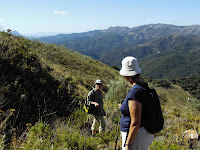In order to fully enjoy your walking, whether low level walking, hill walking or mountaineering, it is important to avoid the formation of blisters. Here are 5 tips to ensure blister free walks:
1) Wear proper walking socks adapted to the time of year – they will have extra padding where needed to ensure comfort and protection from blister prone areas of your feet. Winter walking socks will keep your feet nice and warm and comfortable in winter and summer walking socks will keep your feet nice and dry with their moisture wicking properties. If your feet are extra sensitive, you can also get anti-blister walking socks which are double layered to reduce friction and therefore prevent blisters. Never wear tube socks though!
adapted to the time of year – they will have extra padding where needed to ensure comfort and protection from blister prone areas of your feet. Winter walking socks will keep your feet nice and warm and comfortable in winter and summer walking socks will keep your feet nice and dry with their moisture wicking properties. If your feet are extra sensitive, you can also get anti-blister walking socks which are double layered to reduce friction and therefore prevent blisters. Never wear tube socks though!
2) Wear correct walking shoes suited to the type of walking you are doing: light weight and flexible walking boots or shoes for low level walking (normally low cut). More rigid ones with medium ankle supports for hill walking/trekking. And high-cut boots offering all round high levels of support and duress for mountaineering.
3) Ensure correct size and fit for your new walking boots: always try new walking shoes with a pair of your walking socks since walking socks are bulkier than normal socks. With your boot fully laced up, stand up and your foot should feel comfortable, supported and snug but not tight or pinched in the boot. Then walk around the shop and make sure your toes don’t touch the front of the walking boot, your foot doesn’t move around in the shoe and that your heel doesn’t lift up from the sole. Then, unlace the walking boot and slide your foot as far forward as possible in the boot so that your toes touch the front of the boot; you should be able to place your finger between your heel and the heel of the boot with just a little friction. This is to ensure there is enough clearance at the front of the walking boot when walking downhill as feet normally slide forward in the boot, especially if you are carrying a heavy rucksack. If your finger cannot slide into the gap, then the boot is too small. By the way, never wear brand new walking shoes on a long walk without having broken them in beforehand!
4) If you have a very long and steep descent ahead of you, you can tighten a little bit more your laces at the front of your walking shoes (not too tight that your foot is uncomfortable or pinched and that it is cutting your blood circulation though!) to avoid your toes hitting the front of your shoes when your feet slide forward in the boot. Don’t forget to undo your laces and tighten them normally again once the descent is finished!
5) It is also advisable to take with you blister care products such as special second skin plasters. Nowadays, there are wonderful products available to prevent blisters and to treat and relieve blister pain instantly if you do get some despite of all the care and precautions taken.
such as special second skin plasters. Nowadays, there are wonderful products available to prevent blisters and to treat and relieve blister pain instantly if you do get some despite of all the care and precautions taken.
And to find out how to relieve and relax tired aching feet after a hard day’s walking, visit Sara’s Blog Treat your feet!
1) Wear proper walking socks
2) Wear correct walking shoes suited to the type of walking you are doing: light weight and flexible walking boots or shoes for low level walking (normally low cut). More rigid ones with medium ankle supports for hill walking/trekking. And high-cut boots offering all round high levels of support and duress for mountaineering.
3) Ensure correct size and fit for your new walking boots: always try new walking shoes with a pair of your walking socks since walking socks are bulkier than normal socks. With your boot fully laced up, stand up and your foot should feel comfortable, supported and snug but not tight or pinched in the boot. Then walk around the shop and make sure your toes don’t touch the front of the walking boot, your foot doesn’t move around in the shoe and that your heel doesn’t lift up from the sole. Then, unlace the walking boot and slide your foot as far forward as possible in the boot so that your toes touch the front of the boot; you should be able to place your finger between your heel and the heel of the boot with just a little friction. This is to ensure there is enough clearance at the front of the walking boot when walking downhill as feet normally slide forward in the boot, especially if you are carrying a heavy rucksack. If your finger cannot slide into the gap, then the boot is too small. By the way, never wear brand new walking shoes on a long walk without having broken them in beforehand!
4) If you have a very long and steep descent ahead of you, you can tighten a little bit more your laces at the front of your walking shoes (not too tight that your foot is uncomfortable or pinched and that it is cutting your blood circulation though!) to avoid your toes hitting the front of your shoes when your feet slide forward in the boot. Don’t forget to undo your laces and tighten them normally again once the descent is finished!
5) It is also advisable to take with you blister care products
And to find out how to relieve and relax tired aching feet after a hard day’s walking, visit Sara’s Blog Treat your feet!




































































